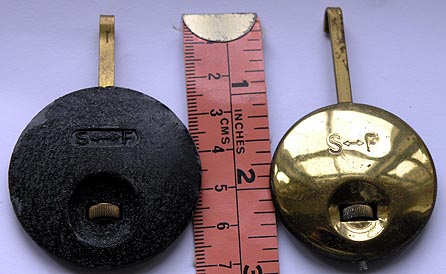 Illustrated above are two "Smith's" pendulums. The crinkle finish bob on the left, although larger and heavier than the fancy polished brass version on the right, beats faster because its centre of gravity is higher.
Illustrated above are two "Smith's" pendulums. The crinkle finish bob on the left, although larger and heavier than the fancy polished brass version on the right, beats faster because its centre of gravity is higher.Rule : A short pendulum will swing faster than a longer one - simply move the bob up, to gain, and move it down, to lose.
The pendulum rod terminates with a rating nut that can be screwed up or down to move the bob and regulate the clock.
 Illustrated above are two "Smith's" pendulums. The crinkle finish bob on the left, although larger and heavier than the fancy polished brass version on the right, beats faster because its centre of gravity is higher.
Illustrated above are two "Smith's" pendulums. The crinkle finish bob on the left, although larger and heavier than the fancy polished brass version on the right, beats faster because its centre of gravity is higher.Turn the rating nut clockwise to make the bob rise, and anticlockwise to move it down. In other words, screw it up to gain : screw it down to lose.
It is important to remember that it is the length of the pendulum that determines the rate that the clock beats.
Timekeeping is not achieved by changing the weight, or size, of the bob as is often misunderstood.
The weight of the bob on the pendulum must be sufficient to overcome the "springyness" of the suspension spring however.
It is important that the suspension fitted is the correct type, and that it is not buckled or torn from mishandling.